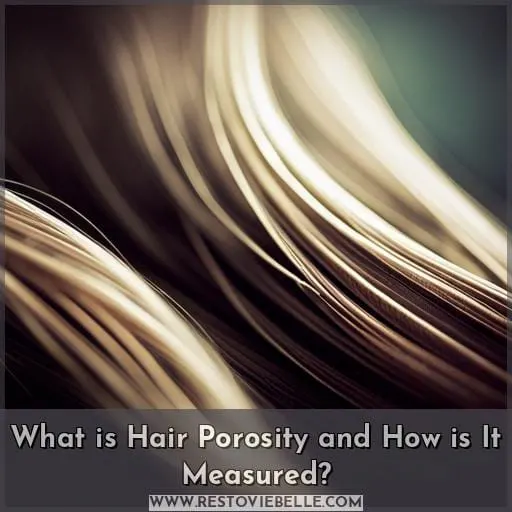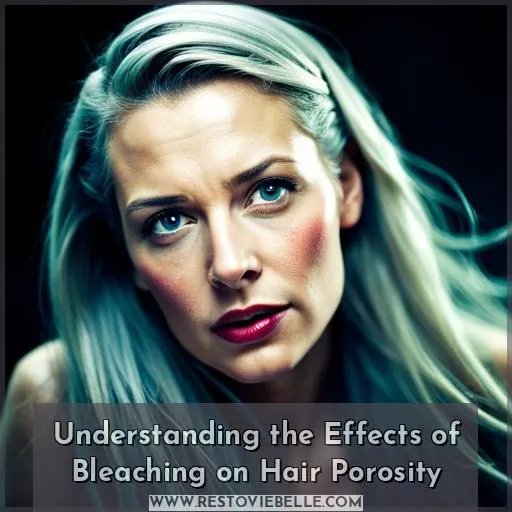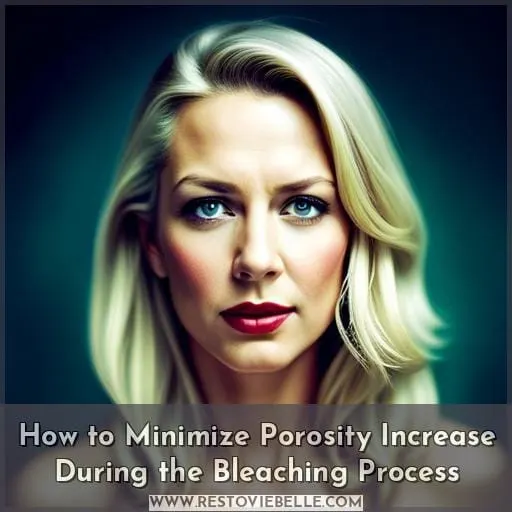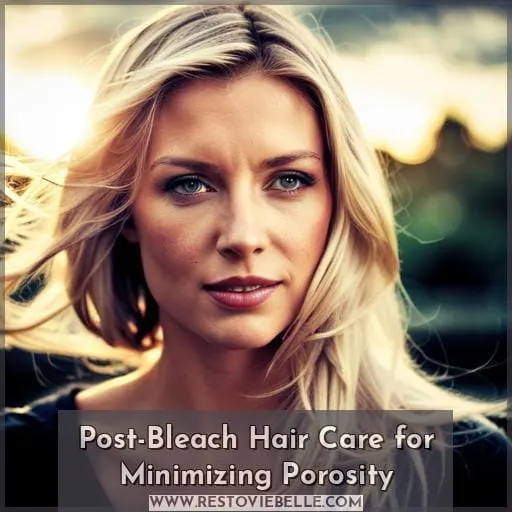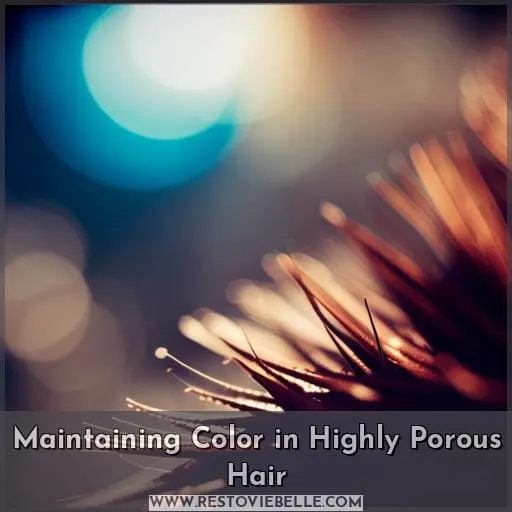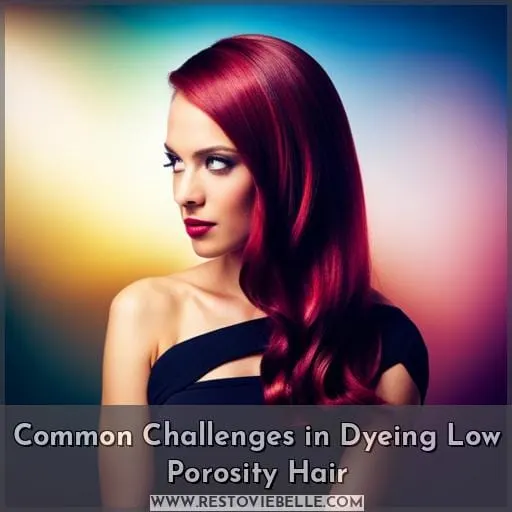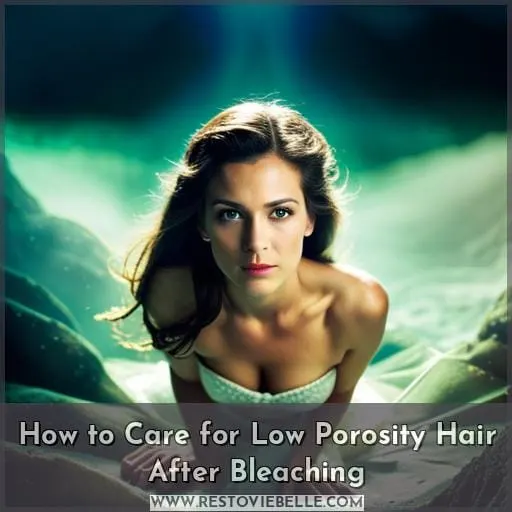This site is supported by our readers. We may earn a commission, at no cost to you, if you purchase through links.

So does bleach really increase porosity? Let’s take a closer look at what happens when we chemically treat our tresses.
Armed with knowledge about what affects our scalp protection barrier and guidance on which products work best for different levels of porousness, you’ll have everything needed to make educated decisions about keeping those valuable follicles strong and radiant!
Table Of Contents
- Key Takeaways
- What is Hair Porosity and How is It Measured?
- Understanding the Effects of Bleaching on Hair Porosity
- Does Bleaching Hair Increase Porosity?
- How to Minimize Porosity Increase During the Bleaching Process
- Post-Bleach Hair Care for Minimizing Porosity
- Maintaining Color in Highly Porous Hair
- Common Challenges in Dyeing Low Porosity Hair
- How to Care for Low Porosity Hair After Bleaching
- Conclusion
Key Takeaways
- Hair porosity should be considered before bleaching to assess the potential impact on moisture absorption and retention.
- Bleaching can increase hair porosity, leading to dryness and breakage.
- Using hydrating shampoos, conditioners, and deep conditioning masks can help restore lost moisture and nutrients in bleached hair.
- Proper application and processing techniques, as well as choosing the right bleach powder, are crucial in minimizing damage to the hair cuticle and controlling porosity.
What is Hair Porosity and How is It Measured?
You can discover the secret to perfect hair care by understanding your unique hair porosity and testing it at home! Hair porosity refers to moisture absorption and retention, with high porosity absorbing but unable to retain moisture while low porosity struggles with absorption.
To measure this, you can conduct a simple test using water – where high porosity sinks quickly while low repels water and floats on top.
This is important because different types of hair require different treatments. For example, slow drying, product buildup, or slow saturation are characteristics of low-porous strands, whereas dryness or frizziness may indicate that your tresses have higher levels of porousness.
Due to UV exposure as well as bleaching processes, which increase the risk of damage due to its weakened cuticle structure, it’s essential that those with more porous locks pay special attention when caring for their mane!
Proper products such as hydrating shampoos/conditioners paired alongside deep conditioning masks help restore lost hydration.
Understanding the Effects of Bleaching on Hair Porosity
Knowing the effects of chemical treatments on your hair’s porosity is essential, as up to 85% of women experience some degree of damage from bleaching. Bleaching can increase porosity levels in your hair, making it more prone to breakage and dryness.
To manage this increased level of porosity, you should use hydrating shampoos and conditioners that help retain moisture in the cuticles. Deep conditioning masks are also important for restoring lost nutrients caused by bleaching.
Additionally, it is recommended to use a gentle bleach powder specifically designed for high-porosity strands when coloring or lightening locks. Follow this with protein treatments that reduce gaps between cells in order to prevent further damage.
Always remember to apply heat protectant before using hot styling tools like curling irons or flat irons. Proper care is key when dealing with chemically treated hair. Keep it conditioned regularly while avoiding overuse of products such as gels or hairsprays, as they could cause further irritation due to their chemical content.
Overall, understanding how different processes affect your tresses will ensure healthier and better-looking locks!
Does Bleaching Hair Increase Porosity?
You may have heard that bleaching hair can increase porosity, but do you really know the impact it has on your hair’s cuticle and how the chemicals used in the process play a role? To understand what happens to your hair when you bleach it, let’s take an in-depth look at the effects of bleaching on porosity.
The Impact of Bleaching on the Hair Cuticle
By understanding the impact of bleaching on your hair’s cuticle, you can better care for and maintain its health and appearance.
The chemicals used in bleaching can damage the cuticle layers, which leads to increased frizz, dryness, breakage, split ends, and loss of elasticity. To prevent further damage, it is important to use treatments specifically designed for high porosity hair.
Deep conditioning masks or protein treatments can help reduce exacerbation caused by chemical exposure.
Additionally, using heat protectants before styling with hot tools helps keep the cuticles sealed off from any additional stressors like heat or UV rays.
With proper care and maintenance, you can ensure your tresses stay strong while enjoying their beautiful color!
The Role of Chemicals in Hair Bleaching
Understanding the chemical composition of bleaching products is essential for safe and successful hair lightening. To ensure that your hair stays healthy during the process, it is important to understand what chemicals are used in each product.
Additionally, selecting the appropriate bleach powder based on desired results is crucial.
Controlling porosity with protein treatments before and after bleaching can help maintain the health of your hair. Using color protection shampoo and conditioner is also recommended to maintain moisture balance after treatment.
It is important to follow product recommendations for best results, including using a heat protectant spray prior to using styling tools.
Bleached hair can become brittle over time if not properly cared for, so following a winter care routine will help keep it looking its best all year round. By understanding the chemistry of hair bleaching and practicing proper maintenance, you can achieve beautiful blonde locks without sacrificing the health of your hair.
How to Minimize Porosity Increase During the Bleaching Process
When bleaching your hair, it is important to take the necessary steps to minimize any increase in porosity. Choosing a gentle bleach powder and properly applying and processing techniques are essential for achieving desired results with minimal damage to the hair.
Choosing a Gentle Bleach Powder
Choosing the right bleach powder can make all the difference in preserving your hair’s porosity and keeping it healthy. Gentle bleaching options are available to minimize damage and reduce increased porosity as much as possible during a color or lightening service.
Safe bleaching products should be used alongside proper hair bleaching techniques for optimal results with minimal risk of damaged cuticles, breakage, dryness, etc.
Post-bleach care is essential to maintain desired results and prevent further damage. Use hydrating shampoos/conditioners and deep conditioning treatments for added moisture retention.
With these solutions, you’ll be able to effectively balance your hair’s natural texture while achieving the desired look without compromising its health.
Proper Application and Processing Techniques
To get the best results from bleaching your hair, it’s important to master the proper application and processing techniques – don’t just throw caution to the wind! Here are a few tips for successful bleaching:
- Use a gentle bleach powder – harsh formulas can weaken hair structure.
- Follow all instructions carefully and track time accurately.
- Seek out expert advice on how long you should leave in each step of your coloring process.
Properly applied bleaches will help manage porosity while protecting against unnecessary chemical impact that could lead to damage or breakage over time.
To keep color vibrant and maintain healthy-looking locks, use color-safe shampoos along with protein treatments as needed for extra moisture control when styling porous tresses.
With care designed specifically to minimize porosity increase during this delicate procedure, you’ll be sure to have beautiful colored locks without compromising their health!
Post-Bleach Hair Care for Minimizing Porosity
After bleaching your hair, it is important to follow a deep conditioning routine and use leave-in conditioners in order to restore moisture levels and control porosity. Deep conditioning treatments can help repair damage caused by the bleaching process while also aiding in hydration, shine, elasticity, breakage prevention, and overall manageability of your hair.
Leave-in conditioners are essential for boosting hydration levels as they provide protein that helps retain moisture for longer periods of time.
Deep Conditioning Treatments to Restore Moisture
After bleaching, replenish your hair’s lost moisture with a deep conditioning treatment to restore softness and shine. Deep conditioning treatments are essential for controlling porosity caused by the harsh chemicals in bleach.
Benefits of these treatments include improved hydration, increased elasticity, reduced breakage, and split ends, as well as enhanced manageability.
With regular deep conditioners that nourish the hair follicles from root to tip every few weeks or months, you can achieve smooth locks with minimal effort.
Moisture Restoration
Porosity Control
Hydration Techniques
Hair Moisture Maintenance
Improved Hydration │ Reduced Breakage │ Increased Elasticity
Vibrant Color & Shine
Unmanageable Locks │ Split Ends │ Damaged Cuticle
Leave-in Conditioners for Porosity Control
Keep your hair healthy and hydrated with a leave-in conditioner that controls porosity. Leave-in conditioners provide an easy way to keep your hair nourished after bleaching, as they can help reduce the porosity increase caused by chemicals in bleach products.
Besides providing moisture, these products also protect from further damage while styling or using heat tools. Look for ingredients like Argan oil and aloe vera to get the most out of their hydrating benefits! Additionally, make sure you choose silicone-free formulas that won’t weigh down thin strands or contribute to product buildup on porous locks.
There are lots of great options available; try L’Oreal Paris Elvive Dream Lengths for high porosity and L’Oreal Paris Elvive Total Repair 5 for low! With regular use, you’ll have healthy-looking tresses all day long without fear of breakage or dryness – even if you’ve recently bleached them!
Maintaining Color in Highly Porous Hair
Maintaining color in highly porous hair can be a challenge. To keep your bleached locks looking healthy and vibrant, it’s important to use a color-safe shampoo and conditioner, as well as protein treatments for porosity reduction.
Color-Safe Shampoo and Conditioner
Protect your porous locks with a color-safe shampoo and conditioner, designed to nourish and restore without sacrificing hue. A tailored system based on your hair porosity type is essential for controlling the effects of damaged hair caused by bleaching.
Consider using a color-safe shampoo that’s hydrating yet light enough not to weigh down your strands. Follow it up with an intense conditioning system that helps keep moisture retention at optimal levels.
To make sure you get all the benefits of these amazing products, opt for weekly deep conditioning treatments as part of a regular maintenance routine.
Protein Treatments for Porosity Reduction
Reinvigorate your locks with protein treatments to reduce porosity and keep your color vibrant for longer! Protein treatments can help restore moisture balance, improve hair elasticity, and provide long-term protection against color fading.
By nourishing the hair cuticle with proteins, you can maintain healthy bleached or colored strands without compromising their quality.
Hair will be better able to retain moisture and protect itself from further damage caused by bleaching or coloring processes. Regular protein treatment helps promote strong hair health while improving overall texture and shine in porous tresses.
Enjoy healthier-looking locks as well as improved longevity of both colors, so you don’t have to worry about frequent retouching sessions due to fading shades.
Common Challenges in Dyeing Low Porosity Hair
Dyeing low porosity hair can be a challenge due to difficulty in color penetration, product buildup, and slow saturation. This type of hair is known for its inability to absorb moisture and products quickly, which makes it difficult to dye effectively without compromising the health of your tresses.
Difficulty in Color Penetration
Dyeing low porosity hair can be difficult as the increased cuticle layer makes it harder for color to penetrate. Bleaching and UV damage often increase porosity, making it even more challenging to dye with consistent results.
The key is understanding how your hair behaves when colored and using specialized coloring techniques and products designed specifically for highly porous strands. Porosity reduction methods, such as protein treatments, are also beneficial in helping reduce the difficulty of dye penetration into deep layers of the cuticles on each strand.
With a few changes in technique or product selection, you’ll be able to achieve beautiful color that lasts without compromising length or strength due to breakage from improper care practices during bleaching or dying processes!
Product Buildup and Slow Saturation
With low porosity hair, product buildup and slow saturation can be a common issue – in fact, up to 85% of people with low porosity hair experience this challenge.
- Use gentle shampoos that are free from sulfates and silicone.
- Avoid heavy oil-based products, which will make it harder for moisture to penetrate your strands.
- Replace traditional conditioner with treatments such as pre-poos or deep conditioning masks tailored to your needs.
- Steaming or using heat when conditioning helps open the cuticle layer, allowing better absorption of moisture into each strand without weighing them down too much.
- Leave-in water-based conditioners provide an all-day moisturizing effect while avoiding buildup on strands over time due to their light texture and formulations designed specifically for those with lower levels of natural oils present within their hair type.
How to Care for Low Porosity Hair After Bleaching
Bleaching low porosity hair can increase its vulnerability to breakage and damage, so it’s important to follow a specific care routine. To keep your bleached locks looking their best, start with a pre-poo treatment for improved moisture absorption, use heat during conditioning for better penetration of the product into the strands, and apply water-based leave-in products throughout the day for all-day hydration.
Pre-Poo Treatment for Improved Moisture Absorption
To maximize moisture absorption, consider a pre-poo treatment for your low porosity hair before bleaching. Replenishing lost moisture is essential to ensure the health of the cuticle and scalp. Pre-poo treatments help maintain hydration levels in low porosity hair by softening strands and sealing in natural oils.
This can significantly reduce damage caused by bleaching, as well as aid with better product penetration when styling or coloring your hair afterward.
Heat Usage During Conditioning for Better Penetration
For better penetration of moisture, try adding a bit of heat to your conditioning routine. Picture the nourishing effects as an oasis for your parched locks – quenching them with much-needed hydration.
Heat aids in porosity management, allowing hair to absorb and retain water more efficiently than without it. When incorporated into a weekly or biweekly conditioning regimen, this technique helps prevent damage from environmental stressors and maintain healthy hair growth over time.
It also boosts the effectiveness of other treatments, such as protein masks, by aiding in further absorption into the scalp and strands. This provides ultimate protection against breakage caused by bleaching or coloring processes.
Water-Based Leave-in Products for All-Day Moisture
Ensure lasting moisture with water-based leave-in products to effectively hydrate your low porosity tresses. A daily hair care routine that includes using a water-based leave-in can help maintain the much-needed moisture for porous hair and control its porosity.
For maximum effectiveness, choose one specifically designed for bleached or dyed hair as it’ll provide additional nourishment and protection from damage caused by dyeing agents.
Water-based leave-ins are also beneficial in providing superior hydration compared to oil-based products, making them an ideal choice for achieving ultimate softness and replenishing lost moisture due to heat styling or sun exposure.
With regular use of these specialized formulas, you’ll be sure to enjoy healthier-looking locks all day long!
- Choose a water-based leave-in product specifically designed for bleached/dyed colored hair.
- Provides additional nourishment & protection from damage caused by dyeing agents.
- More effective at hydrating than oil-based products.
- Helps retain lost moisture due to heat styling/sun exposure.
- Regular use helps achieve healthy-looking locks.
Conclusion
It’s easy to see why you’d want to lighten your hair with bleach – whether it’s to achieve a Daenerys Targaryen-style platinum blonde or simply to add some subtle highlights. But before you do, it’s important to understand the effects that bleaching has on hair porosity.
While it’s true that bleach does increase porosity, the extent of the damage depends on how it’s used. By choosing a gentle bleach powder, applying it properly, and following a post-bleach hair care regimen, you can minimize the damage and keep your hair looking healthy and vibrant.
With the right products, knowledge, and care, you can bleach your hair without taking a toll on its porosity.

